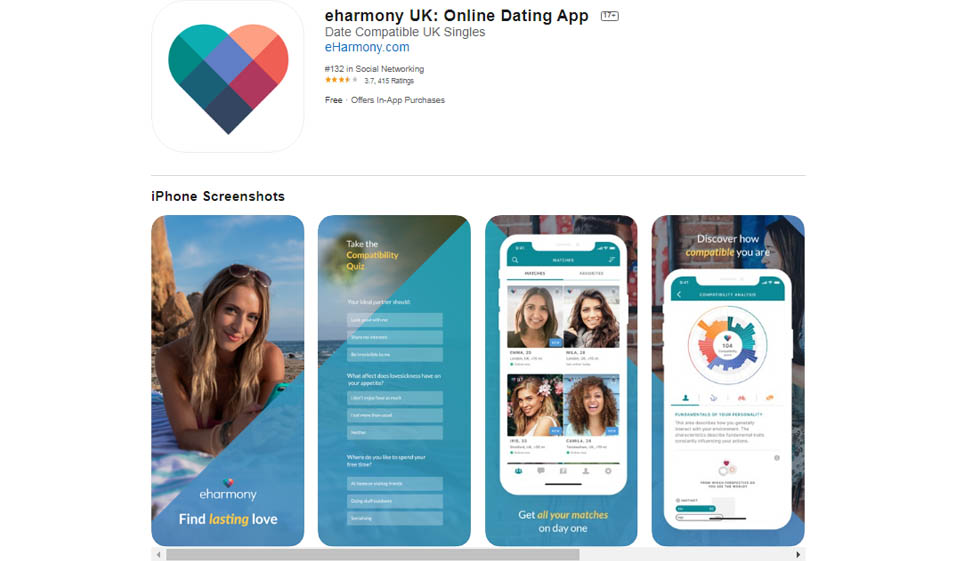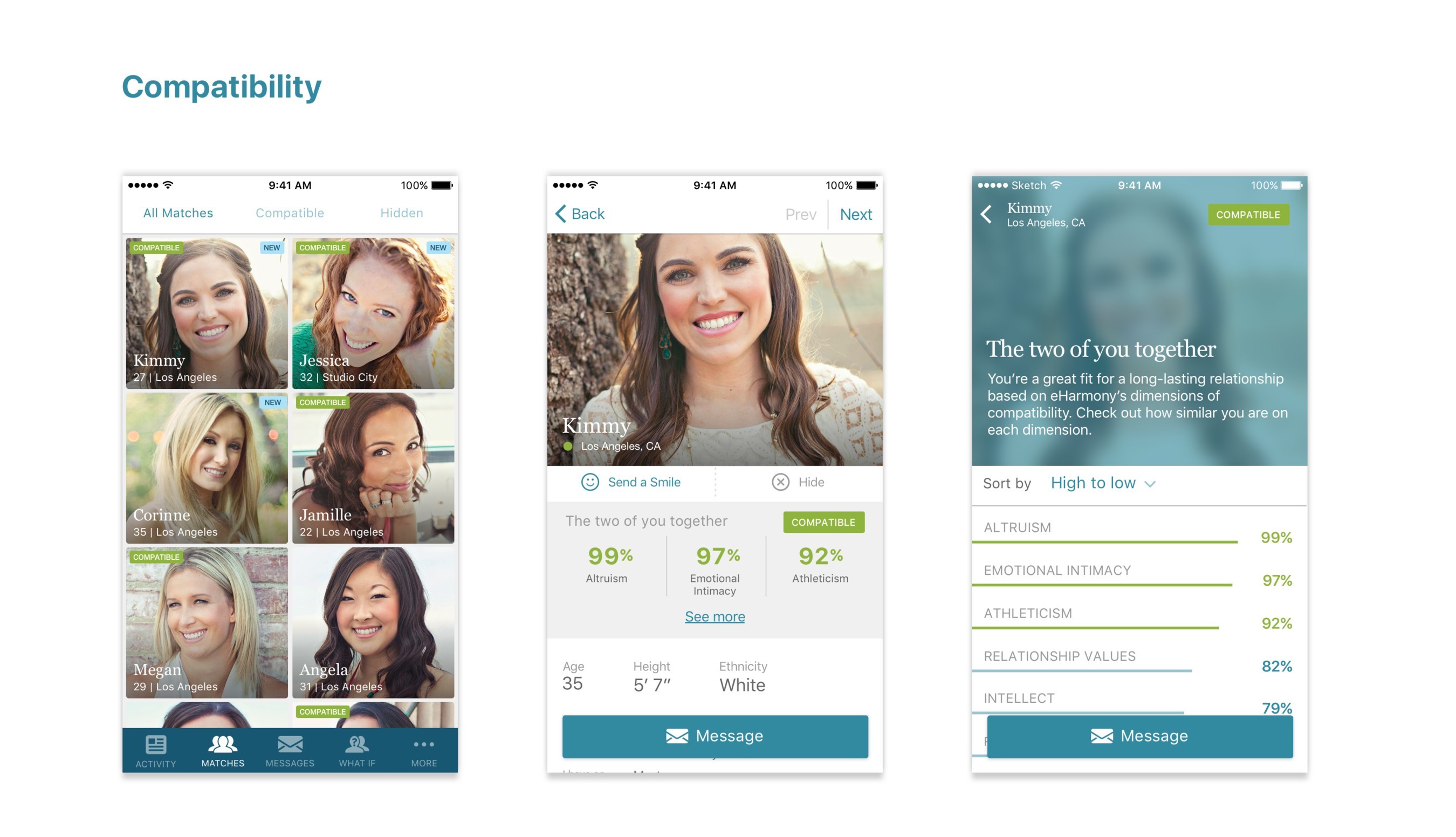What Is A Good Eharmony Score
If you've been in the dating world anytime since 1995, there's a good chance you're familiar with the endless options for online dating websites. Match and eHarmony are two of the oldest and biggest players in the online dating game.
- Well, EHARMONY scores very highly in this context. According to research conducted by Harris, around 542 couples get married every single day thanks to EHARMONY. Another survey found that almost 4% of ALL marriages in the USA are the result of matches made on EHARMONY.
- Eharmony’s unique Compatibility Matching System measures each potential couple on 32 dimensions of compatibility. By asking you a series of questions before we start to match you, we get to know you properly and discover the personality traits that make you unique.
Users award eHarmony app with an average score of 2.7 out of 5 on Google Play. Alternatively, users on the App Store give the service a rating of 4 out of 5. Free and Paid Subscription. EHarmony, while on the pricier side, relies on powerful matching algorithms and is an excellent choice for seniors who seek to date within a specific category of people. EHarmony prides itself on its complicated matching system, which requires users to submit responses to questions regarding themselves and what they are seeking in a partner.
Even with newer dating apps disrupting the industry, Match and eHarmony are still leaders in their niche. Match takes in over $1 billion in revenue annually. In terms of revenue, eHarmony is a distant second, bringing in an estimated $250 million per year.
Their Alexa ranks correlate to their revenue numbers too. Alexa gives Match a global rank of 2,491, while eHarmony comes in at 16,793. Match is the clear winner between these two companies, but we wanted to find out whether there were areas where eHarmony could make up ground against its much bigger competitor.
To do this, we dug into the website analytics of each company. We used Nacho Analytics and SpyFu to take a peek at each company's Google Analytics. What we found was that social media presents a huge opportunity for eHarmony.
Let's set the stage to give you an understanding of the traffic breakdown for both websites:
The main things to take away right off the bat is that both websites do well with direct traffic. eHarmony gets a larger percentage of traffic from organic search, but, as you'll read, it's not a difference-maker. Noticeably absent from eHarmony's traffic breakdown is any amount of social media traffic, which should be a concern for the dating site.
1. Organic traffic: eHarmony looks like the winner, but they're still losing.
In one corner: Match. Match's organic traffic makes up 17.9% of its total website traffic.
In the other corner:eHarmony. Its organic traffic makes up 28.2% of its total website traffic.
The winner? Match.
Similar to what we saw with Airbnb vs. VRBO, eHarmony has an advantage in nonbranded, organic keywords. Nonbranded organic keywords are keywords where the brand's name does not appear in the search term. For example, for keywords similar to “dating sites,” eHarmony ranks in the top five while Match ranks on the second or third page.
Unfortunately, eHarmony is a big loser in one high-volume, nonbranded keyword: “online dating.” Match ranks at number one for this term. eHarmony comes in at number 14, which is on the second page.
It gets even worse when we compare the data from SpyFu. Match ranks for 17,952 keywords. Of those keywords, Match ranks on page 1 for 4,493 of them. That leads to about 3.51M monthly clicks on Match results.
Looking at the same SpyFu data for eHarmony, they rank for 14,002 total keywords, and ranks on page 1 for 5,579 of keywords. Those page 1 rankings look pretty good compared to Match, but all of eHarmony's keywords only drive 1.06M monthly clicks.
WHAT CAN WE LEARN?
eHarmony ranks for a lot of keywords that probably aren't going to move the needle for the company. One of their highest-volume keyword phrases is “what is love.” That's not a terrible keyword phrase for eHarmony, but you have to wonder whether everyone who lands on the website for that term is actually looking to define the word “love,” or if they're just looking for the timeless Haddaway song?
eHarmony would be wise to reevaluate their content strategy, especially around the keywords that Match owns, such as “online dating.”

2. Social media traffic: Both companies lose.
In one corner: Match. Match's social media traffic makes up 3.4% of its total website traffic.

In the other corner: eHarmony. Its social media traffic makes up 0.8% of its total website traffic — a number so small it doesn't even appear on our chart above.
The winner? Neither.
Dating is social, and the stigma around online dating is virtually dead. This combination should mean that both eHarmony and Match have the ability to get a large percentage of traffic from the social platforms.
The truth is, as you can tell from the numbers above, they're both terrible at driving traffic from social.
What's even more surprising is that neither website gets traffic from Instagram. Driving traffic from Instagram is difficult for most companies, but the photo-sharing platform doesn't even appear in the top 10 social traffic referrers for either website. Both dating sites get more traffic from the Russian social media website VK than from Instagram. It's a strange problem, and one that they can correct.
WHAT CAN WE LEARN?
Match and eHarmony need to develop better social strategies — specifically Instagram. It's a perfect platform for both dating sites. We know what you're thinking: “But, Instagram is for Gen Z and millennials, who don't use traditional dating websites!”
The data says otherwise. Hootsuite reports that Instagram has 247 million users over the age of 35. That age range makes up about 75% of Match's users.
3. Direct traffic: Match leads the brand round.
In one corner: Match. Match's direct traffic makes up 59.7% of its total website traffic.
In the other corner: eHarmony. Its direct traffic makes up 44.3% of its total website traffic.
The winner? Match.
Direct traffic is often overlooked, but it's important to understand a website's direct-traffic percentage because it can help you understand how strong that company's brand is. Typically, the more direct traffic a website gets, the stronger the brand. With Match and eHarmony, we see large percentages of direct traffic, likely because each company has spent years building up their brand.
Compatibility Score
WHAT CAN WE LEARN?
Match may have won this round, but that doesn't mean eHarmony is losing. Dating sites are a hyper-competitive industry. Some estimates say that there are over 8,000 of these services worldwide. When you consider that most sites are relatively similar, it's hard for them to get a competitive advantage. That leaves one thing as the competitive advantage: the brand.
Both brands do quite well in direct traffic because they focus on brand awareness. This focus on brand awareness means that people have likely chosen the site they're going to use before they even visit the website. That's the power of a strong brand.
4. New vs. Returning Visitors: Match keeps them coming back for more.
In one corner: Match. Match gets 29.9% of its visitors to return to the website.
In the other corner: eHarmony. eHarmony sees 26.7% of its visitors return.
The winner? Match (although it's a split decision).
We're taking a departure from acquisition sources to look at user behavior. New vs. returning visitors can tell you a ton about your audience, the way they use your website, and even weaknesses in your own product.
For dating sites, returning users are key. Ideally, dating sites want people to set up a profile, message people they're interested in, and come back day after day. That's why it makes sense to look at the new vs. returning visitors. But if we look at this number as a whole, it's not very insightful. It makes more sense to look at these numbers broken down by channel.
We'll set the stage by looking at the overall new vs. returning users for each website:
Match does a better job at returning visitors than eHarmony, but let's dig a little deeper to find some real insight from this data. We'll start by comparing Match's new vs. returning users from social media and direct traffic.
The split for users from social media is 38.9% new visitors and 61.1% returning. This suggests that Match isn't focused on using social as an acquisition channel. Rather, they're doing something that engages current users of the site. This is a bit surprising, considering the sheer number of people who use social media. Ideally, you would want a larger percentage of new visitors from social media than Match's 38.9%.
This likely means that Match either doesn't have a good social advertising strategy or that their budget is very small.
Direct traffic looks great for Match, with 68.5% of their users being new and 31.5% returning. Ideally, they want users to directly return to their website, regardless of how they initially found the website. But it's also important to have a healthy percentage of new users from direct sources. This signifies that your brand-awareness efforts are paying off.
Eharmony Matching Algorithm
Now, let's compare those same two channels for eHarmony's New vs. Returning users.

With social, we're seeing a flip in what we saw with Match. For eHarmony, 63.1% of their social visitors are new, while 36.9% are returning. This could signify that eHarmony is focused on brand awareness on the social platforms. It might also indicate that they're running ads targeted at people who have never used their service before. This is actually a good split to see, but when you consider the tiny amount of traffic eHarmony gets from social (remember, it's just 0.8% of their total traffic), eHarmony needs to seriously reevaluate their strategy on social.
Direct traffic takes a hit for eHarmony, too, with the split being 73% new, 27% returning. Returning visitors are 4.5% lower than Match's returning users. While that might seem like a small percentage, in real numbers it means eHarmony is losing thousands of users because they're not returning at the same rate as those on Match. This could signify that eHarmony has an inferior product, or that their audience's expectations don't align with the service eHarmony is providing.
WHAT CAN WE LEARN?
Overall, both sites do a decent job of gaining new users and converting them to returning users. It's obvious that Match should use social as more of an acquisition channel to try to gain more new traffic from the platform.
eHarmony, on the other hand, needs to take a look at what they can do to improve their returning users from direct sources. That's not an easy task or a quick fix, but it is something they need to take a serious look at.
Adding up the scores

Match won rounds 1 and 3, organic traffic and direct traffic. Their utter dominance on organic traffic makes it tough for eHarmony to make up any ground there.
eHarmony could make moves with direct traffic, but they'll have to focus on brand awareness, which is a long-term strategy. Rounds 2 and 4 were a different story.
Round 2, the social media round, was a loss for both companies. If eHarmony can sort out their social media strategy, they have a great opportunity to gain some ground on Match. Round 4, new vs. returning visitors, went to Match because of its ability to return users at a higher rate, which may suggest they have a better service.
The final score:
- Match: 3
- eHarmony: 0